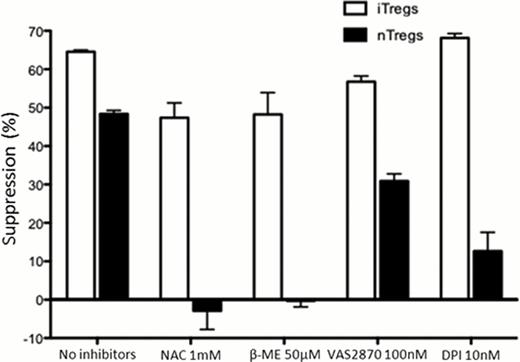Abstract
Abstract 2146
Naturally-occurring, thymus-derived regulatory T cells (nTregs) have clinically important roles in suppression of autoimmunity and graft versus host disease but are maladaptive in the tumor microenvironment where their activity results in the suppression of anti-tumor immunity. Induced regulatory T cells (iTregs) arise in the periphery under the influence of TGF-beta and have related phenotypic features and function. However, the mechanisms by which nTregs and iTregs impart suppression remain poorly understood. We have previously shown that NADPH oxidase derived reactive oxygen species (ROS) are important for nTreg suppressive function. We extend these observations and find distinct differences in the effect of antioxidants and NADPH oxidase inhibitors on blocking nTreg function but not iTreg function thus implying a role for ROS in the function of the former but not the latter. The contrasting requirement for ROS is further supported by distinct differences in expression of oxidant related genes in nTregs and iTregs.
Murine nTregs were isolated by flow cytometric sorting for CD4+CD25++ T cells. Murine iTregs were induced from spleen sorted naïve T cells (CD4+CD44-) by incubating with TGF-beta and IL-2 and the resulting cells were sorted for the CD25++ subset. For suppression assays, nTregs and iTregs were incubated for three days with CFSE-labeled conventional T cells (Tc; CD4+CD25−) with antioxidants or NADPH oxidase inhibitors, as indicated. The proliferation of Tc co-incubated with Tregs was compared to their proliferation in identical conditions lacking Tregs in classical suppression assays. In some cases, nTregs and iTregs were co-incubated with CFSE-labeled Tc for two days in conditions identical to suppression assays to activate their suppressive function then resorted and subjected to RNA extraction and analysis of mRNA expression of a series of oxidant related genes.
The antioxidants n-acetylcysteine (NAC; 1mM) and beta-mercaptoethanol (B-ME; 50 uM) had only small effects on suppression imparted by iTregs (p<0.01) while they completely blocked suppression by nTregs (see figure; p<0.0001). NADPH oxidase inhibitors VAS2870 (100nM) and diphenyleneiodonium (DPI; 10nM) demonstrated only mild effects on suppression by iTregs (p<0.01) while markedly reducing suppression by nTregs (p<0.001; see figure). iTregs derived from mice lacking a functional NADPH oxidase complex due to a mutation in the NADPH oxidase subunit NCF1 (NCF1−/−) demonstrated suppressive activity that was similar to wild type (NCF+/+) iTregs, thus genetically confirming no role for NADPH oxidase derived ROS for iTreg-mediated suppression. To evaluate dynamic functional differences between nTregs and iTregs, the expression of a series of ROS related genes was analyzed in purified Tregs with activated suppressive function. This demonstrated overexpression of two genes involved in oxidant detoxification in nTregs: sulfiredoxin1 (SRXN1; >16 fold overexpression in nTregs vs iTregs; mean of 3 experiments) and glutathione peroxidase 3 (GPX3; approximately 3-fold overexpression in nTregs vs iTregs; mean of 3 experiments). Overexpression of SRXN1 and GPX3 in nTregs was confirmed with additional unrelated assays. SRXN1 is a transcriptional target for the cytoprotective transcription factor nuclear factor erythroid 2-related factor 2 (NRF2). Therefore, we separately evaluated NRF2 expression and found approximately 2.5-fold mean overexpression in nTregs vs iTregs. Thus, because ROS is an important mediator of nTreg suppressive function we hypothesize that activation of NRF2, and downstream antioxidants such as SRXN1, are critical for the oxidant protection of nTregs themselves during suppression.
Our findings illustrate fundamental differences in suppressive mechanisms employed by murine nTregs and iTregs and highlight a role for ROS in the former but not the latter.
No relevant conflicts of interest to declare.
Author notes
Asterisk with author names denotes non-ASH members.


This feature is available to Subscribers Only
Sign In or Create an Account Close Modal